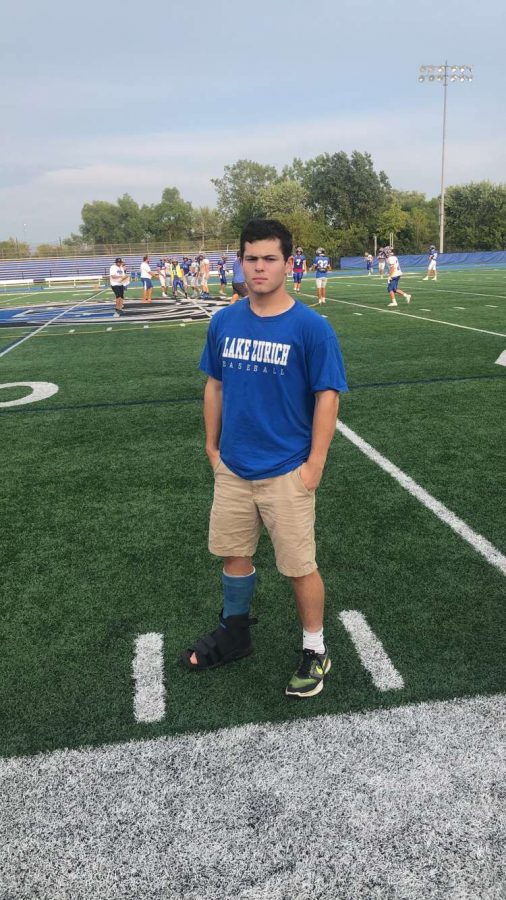Break-ing news
Injuries among student athletes
Photo by Photo used with permission of Eddie Dlatt
Eddie Dlatt, senior, is out for his last season of football due to an injury.
Athletic injuries are common among student-athletes, especially those in high contact sports. One major injury can end an athlete’s career or prevent them from playing later on, but proper care can lead to recovery.
Lasting Effects:
Alyson Kee, senior, plays soccer and golf, but is challenged by a past injury of hers. During soccer season of her freshman year, Kee twisted her ankle but kept playing on it unknowingly causing more damage. By the end of the year, Kee found out she hurt her ligament and was put in a boot.
“[Being out for an injury is] definitely hard because I love my sports, so I want to always be a part of them. That’s kind of why when I was first injured, I didn’t say anything right away, but that just ended up making it worse. There’s a give and take. You have to make sure you’re taking care of yourself,” Kee said.
When Kee was out for her injury, she attended practices and games to support her teammates and cheer them on.
Now her ankle is weak making sports more difficult. She has to be cautious when playing, and “[has] to think about if I ever tweak it using a brace or something like that,” Kee said. “So now if I ever feel pain I make sure I tell the doctor right away. I think [injury prevention is] definitely the athletes’ responsibility. Looking back on my injury that I had, I didn’t handle it the way I should have,” Kee said.
Getting back to the game:
Eddie Dlatt, senior, is involved in football and baseball. He is out for his last high school season of football due to an injury that occurred during practice a week before school started.
“We were doing a drill at football practice, and someone tackled me. It wasn’t even full speed, but I came down awkwardly on my leg. It basically twisted and then I pretty much knew from there that something was wrong,” Dlatt said.
Immediately, Dlatt went to the trainers. He was not able to walk on his leg and it “felt kind of different than [a smaller injury],” Dlatt said. The injury worsened so Dlatt went to get an X-ray. The results showed that he had fractured his fibula (a bone in the lower leg).
“[The doctor] put a cast on it for three weeks, no walking. Followed by two weeks with the cast and walking on it. After five weeks, the cast will be off, and [I’ll] start doing [physical] therapy for it and hopefully be back in six to eight weeks,” Dlatt said.
It’s hard sitting out for football his senior year, according to Dlatt, especially since he has been working since January. Dlatt is not letting his injury keep him from being a part of the team, “I’ve been going to practice everyday, meetings, [and] watching film with the team.
Pretty much all [everything] besides playing,” Dlatt said.
Throughout his recovery, Dlatt’s coaches have been supportive, according to Dlatt.His coaches have been “really positive, offering help whenever I need it,” Dlatt said. “They’ve been there for me if I ever need to talk to them about anything related to it.”
Dlatt has thought about playing baseball in college and has talked to a few coaches. Since the injury has to do with a bone he should be good to play once his leg has healed, and “see where I am once I get back to full strength,” Dlatt said. “Then I’ll go from there.”
What the coaches think:
Ron Planz, head football coach:
“Well, number one thing is sleep. Student athletes need sleep is the number one performance enhancer they can have as sleep. And a lot of the lack of sleep leads to injuries. So sleep and good nutrition are the top two things that student athlete could do to prevent injuries,” Planz said.
Lindsay Puppolo, soccer coach:
“Student athletes should always eat healthy, drink lots of water to stay hydrated, and sleep well. I think it is important for student athletes to be aware of how their body feels. If anything feels off, it is important to check in with a coach or trainer to prevent any further injury,” Puppolo said. “Also, players cannot rush coming back after an injury. Players need to take it slow and make sure they are fully recovered before playing at full speed.”
Terry Coughlin, boys basketball coach:
“We talk a lot about injury prevention. The most important thing I can do as a coach is set up a practice schedule that doesn’t overload our athletes physically and mentally,” Coughlin said. “Mentally may be the most important aspect [because] a tired athlete, mentally, is more likely to injure themselves during competition. Athletes must take care of themselves physically such as stretching and strength training. This does not prevent injuries alone [but] it helps and gives athletes the best chance of staying healthy.”

Sophia Babcock is a senior and this is her third year on staff and fourth year in the journalism program. This year she is excited to take on the role...

